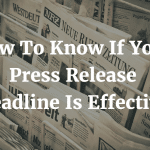
Why Putting a Reporter’s Needs Before Your Own is Important
When you’re focused on your brand’s press and public relations, it can be difficult to focus on the needs of others. However, that’s exactly what you need to do if you want to work successfully with a reporter or other members of the media. Putting their needs before your own is important.
Making the Pitch
When you make a pitch to a reporter, you’re likely quite anxious about not only the process but also their response. It’s easy to be focused on what you need from the reporter. If you can shift your attention to what the reporter needs, you will get a better response.
Audience:

When writing your pitch, keep the journalist’s audience at the forefront. What do they want to know and how will your information help them?
Your chosen media representative is not going to write the story for themselves –they are writing it for their audience. If you are focused on their audience, it will help you create a stronger pitch.
Timeline:
Yes, you probably have a timeline to work with, but the journalist doesn’t care about your timeline. They have deadlines to meet.
Try and learn their timeline and work extra hard to meet it. It shows that you care enough to go a step further. This, in turn, will help you create a solid relationship with that person.
Make It Easy:
If we’re being up front, a pitch that basically writes the story for them stands a better chance of getting covered.
Yes, a pitch should be short and sweet, but you also want to paint a picture of the story. Give away as much details as needed, but keep them wanting to read the release.
Writing the Release

Writing a press release is different than sending a pitch. Yet the same “journalist first” approach should be embraced.
Think about the type of journalists you are pitching to before writing your release. Include all the informative details they are going to need when writing the story.
Side Note: Never forget your contact info!
Newsworthy:
Ask yourself, will the reporter think this is newsworthy? Is it timely, relevant, and important for their audience? Will their audience care? Put yourself in their shoes and ask these important questions before you send them a press release.
Facts, Quotes, & Information:
In addition to placing relevant and valuable facts in your release, be sure to provide them with resources for further information. This could be a link to a downloadable PDF or a link directed to your media page.
You should always put the reporter first when building a media relationship. Promote their content and provide them with assistance when needed. This shows them that the relationship you are trying to cultivate is a two-way street. And when you’re working together for the first time, be the best professional they’ve ever worked with, so they want to work with you again.











